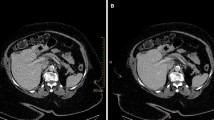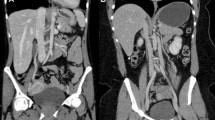Abstract
Objectives
To compare image quality and low-contrast detectability of an integrated circuit (IC) detector in abdominal CT of obese patients with conventional detector technology at low tube voltages.
Methods
A liver phantom with 45 lesions was placed in a water container to mimic an obese patient and examined on two different CT systems at 80, 100 and 120 kVp. The systems were equipped with either the IC or conventional detector. Image noise was measured, and the contrast-to-noise-ratio (CNR) was calculated. Low-contrast detectability was assessed independently by three radiologists. Radiation dose was estimated by the volume CT dose index (CTDIvol).
Results
The image noise was significantly lower, and the CNR was significantly higher with the IC detector at 80, 100 and 120 kVp, respectively (P = 0.023). The IC detector resulted in an increased lesion detection rate at 80 kVp (38.1 % vs. 17.2 %) and 100 kVp (57.0 % vs. 41.0 %). There was no difference in the detection rate between the IC detector at 100 kVp and the conventional detector at 120 kVp (57.0 % vs. 62.2 %). The CTDIvol at 80, 100 and 120 kVp measured 4.5–5.2, 7.3–7.9 and 9.8–10.2 mGy, respectively.
Conclusions
The IC detector at 100 kVp resulted in similar low-contrast detectability compared to the conventional detector with a 120-kVp protocol at a radiation dose reduction of 37 %.
Key Points
• An integrated circuit (IC) detector significantly improves the quantitative image quality
• The IC detector results in a significant improvement of low-contrast detectability
• Reduction of tube voltage to 100 kVp is feasible in obese patients
• The IC detector holds great promise for improving patient safety


Similar content being viewed by others
References
Nguyen DM, El-Serag HB (2010) The epidemiology of obesity. Gastroenterol Clin N Am 39:1–7
de Onis M, Blossner M, Borghi E (2010) Global prevalence and trends of overweight and obesity among preschool children. Am J Clin Nutr 92:1257–1264
Prospective Studies Collaboration, Whitlock G, Lewington S, Sherliker P, Clarke R et al (2009) Body-mass index and cause-specific mortality in 900 000 adults: collaborative analyses of 57 prospective studies. Lancet 373:1083–1096
Boeing H (2013) Obesity and cancer–the update 2013. Best Pract Res Clin Endocrinol Metab 27:219–227
Brenner DJ, Hall EJ (2007) Computed tomography–an increasing source of radiation exposure. N Engl J Med 357:2277–2284
Schindera ST, Nelson RC, Toth TL, Nguyen GT, Toncheva GI et al (2008) Effect of patient size on radiation dose for abdominal MDCT with automatic tube current modulation: phantom study. AJR Am J Roentgenol 190:W100–W105
Wang AJ, Goldsmith ZG, Wang C, Nguyen G, Astroza GM et al (2013) Obesity triples the radiation dose of stone protocol computerized tomography. J Urol 189:2142–2146
Sodickson A, Baeyens PF, Andriole KP, Prevedello LM, Nawfel RD et al (2009) Recurrent CT, cumulative radiation exposure, and associated radiation-induced cancer risks from CT of adults. Radiology 251:175–184
Smith-Bindman R, Lipson J, Marcus R, Kim KP, Mahesh M et al (2009) Radiation dose associated with common computed tomography examinations and the associated lifetime attributable risk of cancer. Arch Intern Med 169:2078–2086
Husarik DB, Schindera ST, Morsbach F, Chuck N, Seifert B et al (2014) Combining automated attenuation-based tube voltage selection and iterative reconstruction: a liver phantom study. Eur Radiol 24:657–667
Mathews JD, Forsythe AV, Brady Z, Butler MW, Goergen SK et al (2013) Cancer risk in 680,000 people exposed to computed tomography scans in childhood or adolescence: data linkage study of 11 million Australians. BMJ 346:f2360
Morsbach F, Desbiolles L, Plass A, Leschka S, Schmidt B et al (2013) Stenosis quantification in coronary CT angiography: impact of an integrated circuit detector with iterative reconstruction. Invest Radiol 48:32–40
Menke J (2005) Comparison of different body size parameters for individual dose adaptation in body CT of adults. Radiology 236:565–571
Medicine AAoPi (2011) Size-specific dose estimates (SSDE) in pediatric and adult body CT examinations. American Association of Physicists in Medicine AAPM Report No. 204
Chakraborty DP (2006) Analysis of location specific observer performance data: validated extensions of the jackknife free-response (JAFROC) method. Acad Radiol 13:1187–1193
Desai GS, Uppot RN, Yu EW, Kambadakone AR, Sahani DV (2012) Impact of iterative reconstruction on image quality and radiation dose in multidetector CT of large body size adults. Eur Radiol 22:1631–1640
Sardanelli F, Hunink MG, Gilbert FJ, Di Leo G, Krestin GP (2010) Evidence-based radiology: why and how? Eur Radiol 20:1–15
Schindera ST, Odedra D, Raza SA, Kim TK, Jang HJ et al (2013) Iterative reconstruction algorithm for CT: can radiation dose be decreased while low-contrast detectability is preserved? Radiology 269:511–518
Morsbach F, Bickelhaupt S, Ratzer S, Schmidt B, Alkadhi H (2014) Integrated circuit detector technology in abdominal CT: added value in obese patients. AJR Am J Roentgenol 202:368–374
Mettler FA Jr, Bhargavan M, Faulkner K, Gilley DB, Gray JE et al (2009) Radiologic and nuclear medicine studies in the United States and worldwide: frequency, radiation dose, and comparison with other radiation sources–1950–2007. Radiology 253:520–531
Curry TS, Dowdey JE, Murry RC, Christensen EE (1990) Christensen's physics of diagnostic radiology, xi. Lea & Febiger, Philadelphia, p 522
Schindera ST, Torrente JC, Ruder TD, Hoppe H, Marin D et al (2011) Decreased detection of hypovascular liver tumors with MDCT in obese patients: a phantom study. AJR Am J Roentgenol 196:W772–W776
Robinson E, Babb J, Chandarana H, Macari M (2010) Dual source dual energy MDCT comparison of 80 kVp and weighted average 120 kVp data for conspicuity of hypo-vascular liver metastases. Invest Radiol 45:413–418
Acknowledgements
The scientific guarantor of this publication is Dr. Sebastian Schindera. The authors of this manuscript declare relationships with the following companies: Siemens Healthcare. This study has received funding from Siemens Healthcare. Dr. Zsolt Szucs kindly provided statistical advice for this manuscript. One of the authors has significant statistical expertise. Institutional review board approval was not required because it was a phantom study. Written informed consent was obtained from all subjects (patients) in this study. Written informed consent was waived by the institutional review board. Approval from the institutional animal care committee was obtained. Methodology: prospective, experimental, performed at one institution.
Author information
Authors and Affiliations
Corresponding author
Rights and permissions
About this article
Cite this article
Euler, A., Heye, T., Kekelidze, M. et al. Assessment of image quality and low-contrast detectability in abdominal CT of obese patients: comparison of a novel integrated circuit with a conventional discrete circuit detector at different tube voltages. Eur Radiol 25, 687–693 (2015). https://doi.org/10.1007/s00330-014-3459-4
Received:
Revised:
Accepted:
Published:
Issue Date:
DOI: https://doi.org/10.1007/s00330-014-3459-4




